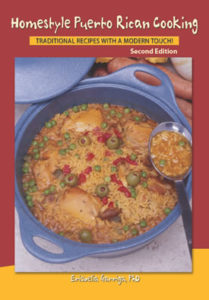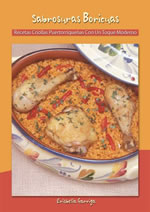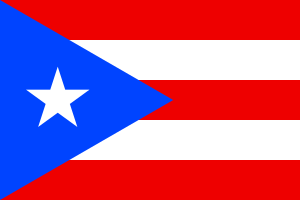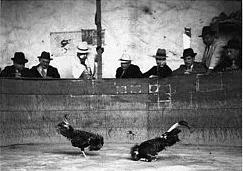Preserving our traditional Puerto Rican cuisine. . .
by Erisbelia Garriga
Traditional Puerto Rican Food
Each ethnic group considers its own typical cuisine as the best food in the world. At the same time virtually all cuisines have had foreign influence. Puerto Rican cuisine has been no different, with contributions from Spanish, French, African and more recently American food. One pillar of Puerto Rican cooking is its seasoning, sofrito, which gives it its distinctive flavor.
I was born and raised in Aguadilla, Puerto Rico. I grew up among women who loved cooking, always in the kitchen preparing all kinds of dishes. Mention that you had a particular craving for something and one of them would get up and begin preparing it, without recipes. And whatever they made, it would taste wonderfully great. Today we still crave some of those traditional dishes.

Puerto Rican food is very delicious, especially when you remember the smoky flavors provided by using wood as heat when our mothers and grandmothers cooked. This was food eaten with your fingers, licking them as you finished eating. I savor the opportunity I had to taste and remember those dishes. It‘s harder today to recapture that distinctive flavor due in part to the equipment use in the modern kitchens. People seek out kiosks or come y vetes (old-fashioned fast food places) and order alcapurrias, sorullos, empanadillas, among others. In every town in the Island and in almost all states in the United States where Puerto Ricans live, there is always a local who can point you to those eateries.
Puerto Rican Cuisine
Puerto Ricans’ passion for food and their culture is expressed through their cuisine. Nearly every occasion is celebrated with food and music to enjoy the moment, especially traditional cooking: lechón asado or pernil (roast pork), rice with pigeon peas, rice with chicken, pasteles, asopao de gandules, de camarones, de pollo, among others, even when it’s not the season for some of these dishes. Needless to say, the “fast food” influence has changed the way we eat. We seem not to have enough time to cook and enjoy delicious traditional dishes the way we used to with our families.
Yet, chefs have been revolutionizing our traditional food, using their skills to create new dishes, opening the door for others to do the same by using their imagination. Increasingly, there is a fusion of cuisines, combining our traditional with that of other ethnic groups using locally produced ingredients. Our typical “pastel”, which used to be prepared with green bananas only is now prepared using breadfruit, ñame, yautía, calabaza, apio, malanga, rice, often in combination. There are festivals in various towns in Puerto Rico celebrating individual ingredients creating exciting new dishes, such as pigeon peas cake, pigeon peas custard, and pasteles de apio.
It’s safe to say our traditional dishes will never disappear as long as there are people who wish to preserve them, who are willing to pass them on to their children, passing on their knowledge from one generation to the next. This is their legacy, and one venue is through the written word. This, then, is the purpose of Sabrosuras Boricuas and Homestyle Puerto Rican Cooking. ¡Buen provecho! Enjoy!
 Erisabelia Garriga, a native of Aguadilla, Puerto Rico, did her undergradutate studies at the University of Puerto Rico, Rio Piedras Campus, and graduate studies at New York University. After some years in high school and college teaching, shes worked for the NYC Health and Hospitals Corporation, from which she is now retired. Ms. Garriga has published two cookbooks: Homestyle Puerto Rican Cooking, Traditional Recipes with a Modern Touch! and Sabrosuras Boricuas, Recetas Criollas Puertorriqueñas con un Toque Moderno. You can visit her website eriskitchen.net or Follow her on Facebook |

This family cookbook will introduce the reader to our treasured classic Puerto Rican recipes as well as new ones. It is a collection of family recipes and the result of my experimentation with them. It is about innovation, taking simple ingredients and playing them off each other. The majority of the recipes are from my parents, others are personal and a few others from family members and friends. There are variations and familiar dishes were recreated, sometimes using substitute ingredients. Though family members, using the same ingredients, will prepare similar dishes in a different way, the end result is, nonetheless, a delicious, enjoyable dish. |
 Sabrosuras Boricuas, Puerto Rican Recipes with a Modern Touch is a family recipe's collection with a lot of pictures and easy to prepare. Sabrosuras Boricuas received an "Honorific Mention" in the "9th International Latino Book Awards" celebrated in the Javits Center, in New York, on May 31, 2007. Also won in the category of the "Better Latin Book Cuisine" in Latin America, in the contest "Gourmand World Cookbook Awards 2006" celebrated in Madrid, Spain. The book will be at the "Olympic Exhibition" of cuisine books and wines that Gourmand will exhibit in Beijing during the Olympic year from August, 2007 to August, 2008. Sabrosuras Boricuas is a gastronomic trip to the Island of Enchantment without the expense of the trip. It is the ideal gift for any occasion as birthday, weddings, or to give your thanks to that special person. Related Articles Puerto Rican Coquito Recipe |

 Vejigante New York City
Vejigante New York City Vejigante with Mask Puerto Rican Parade New York City
Vejigante with Mask Puerto Rican Parade New York City



 The next stop on the tour takes guests to an amazing replica of the very first Bacardi distillery with huge wood barrels filled with
The next stop on the tour takes guests to an amazing replica of the very first Bacardi distillery with huge wood barrels filled with 





 Santeria Religion[/caption]
Santeria Religion[/caption]
 Seven African Powers[/caption]
When an animal is to be sacrificed, Its done by a priest or Babalu only. We can have altars and offer food, money, coffee, but we are not to kill an animal. Animals are used only in major situations, Such as ones life is in danger or badly cursed. With all religions, there is good and bad people.. This does not make the religion itself bad but the people who use it for harm.
Seven African Powers[/caption]
When an animal is to be sacrificed, Its done by a priest or Babalu only. We can have altars and offer food, money, coffee, but we are not to kill an animal. Animals are used only in major situations, Such as ones life is in danger or badly cursed. With all religions, there is good and bad people.. This does not make the religion itself bad but the people who use it for harm.
 Chango- a.k.a. Santa Barbara
Chango- a.k.a. Santa Barbara
